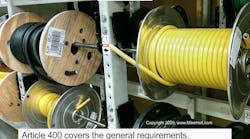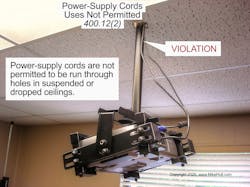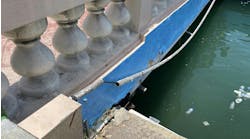Article 400 covers the general requirements, applications, and construction specifications for flexible cords and flexible cables. You can get a sense of the sheer variety of them and their applications by reviewing Table 400.4 (Fig. 1).
Why is this not Article 3xx, and why is it in Chapter 4 instead of Chapter 3? The NEC does not consider flexible cords to be a wiring method like those addressed in Chapter 3. Unlike wiring methods, flexible cords and flexible cables are not affixed to a surface. In addition, you don’t install them in the sense that you install a Chapter 3 wiring method.
They may, however, be used in a building to connect equipment to a permanent power source. Luminaires and sump pump motors are two examples of this type of use. The former permits easy configuration changes, while the latter accommodates vibration.
You don’t run flexible cords and flexible cables in raceway, although you may use cord guards or other devices such as cable looms to protect them from mechanical damage and — where run near walkways — to prevent them from presenting a tripping hazard.
While these cords and cables are manufactured to standards that make them safe to use, they are considered safe to use only when identified for the use and the application for which designed. Therefore, always use the flexible cord (and fittings) right for the job.
For example, use cords listed for a wet location if you are using them outdoors. The jacket material of a flexible cord is tested to maintain its insulation properties and other characteristics in the environments for which it has been listed. It may seem logical that any cord jacket is suitable for wet conditions; after all, it’s some sort of plastic. Yes, any jacket used today will probably keep water out under normal use. However, has it been tested to keep electricity in while it’s wet? What about after it has baked in the hot sun for a few weeks? The suffix “W” at the end of a flexible cord type designates that the flexible cord is water- and sunlight-resistant [Table 400.4, Note 9].
Table 400.4 will help you identify whether a given type of cord or cable fits your intended application. Though it’s a monster table that runs several pages, its arrangement is based on the Type Letter. Those are in alphabetical order starting with “C” and ending with “W.” The Type Letter is the second column, not the first column, which is a little confusing at first glance.
Ampacity
You need to use a cord that has suitable ampacity for the application. Tables 400.5(A)(1) and 400.5(A)(2) are important references to turn to when looking for the ampacity of flexible cords and cables. These cords and cables include various types of wire that might be used for lamps, appliances, extension cords, drop and pendant lights, pool pumps, and so on.
Table 400.5(A)(1) lists the ampacity for the individual conductors inside manufactured flexible cords. Table 400.5(A)(2) lists the ampacity for overall cord assemblies with not more than three current-carrying conductors in an ambient temperature of not more than 86˚F.
Ordering Cords
If you need to order cord for a project, be specific. What you ask for is exactly what you get. It’s not like ordering a wiring method.
For example, consider this common wiring method: 14/2 nonmetallic sheathed cable (NMC) [Art. 334]. It has a black conductor, a white conductor, and an equipment grounding conductor. However, 14/2 SJ cord will have only two conductors and no equipment ground while 14/3 SJ has three conductors, including the equipment ground. Thus, be sure to order by the total number of conductors needed for your installation.
Uses Permitted
Where exactly can you use flexible cords and flexible cables? Within the scope of Article 400, they can be used for [Sec. 400.10(A)]:
(1) Pendants [receptacles [Sec. 210.50(A)] and boxes [Sec. 314.23(H)]].
(2) Wiring of luminaires [Sec. 410.24(A) and Sec. 410.62(B)]. Note that you don’t use flexible cords inside ceiling areas or other hidden places because rodents can chew through the insulation. In those locations, you must use something critters can’t chew through. If you still want that flexibility because you might move the light fixture, then something like Type AC cable [Art. 320] works well. In fact, you can buy “fixture whips” specifically for this purpose.
(3) Connection of portable luminaires, portable and mobile signs, or appliances [Sec. 422.16].
(4) Elevator cables.
(5) Wiring of cranes and hoists.
(6) Connection of utilization equipment to facilitate frequent interchange [Sec. 422.16].
(7) Prevention of the transmission of noise or vibration [Sec. 422.16].
(8) Appliances where the fastening means and mechanical connections are specifically designed to permit ready removal for maintenance and repair, and the appliance is intended or identified for flexible cord connections [Sec. 422.16]. Note that water heaters, furnaces, and other appliances fastened in place cannot be connected with a flexible cord unless the appliances are specifically identified to be used with a flexible cord [Sec. 422.16(A)(2)].
(9) Connection of moving parts.
Attachment plugs are required for flexible cords used in any of the following applications:
• Portable luminaires, portable and mobile signs, or appliances [Sec. 400.10(A)(3)].
• Stationary equipment to facilitate its frequent interchange [Sec. 400.10(A)(6) and Sec. 422.16(A)(1)] (Fig. 2).
• Appliances specifically designed to permit ready removal for maintenance and repair and identified for flexible cord connection [Sec. 400.10(A)(8)].Uses Not Permitted
You can’t use flexible cords and cables in place of a Chapter 3 wiring method for fixed wiring, although some people try. Sometimes, it’s taken to extremes. For example, to avoid running raceway and conductors for about 400A of 480V power to a new production room, maintenance personnel at a Tennessee appliance plant bundled many Type SO flexible cords with tie wraps into a collection of cord bundles (10 cords per bundle). They even hung the resulting bundle of bundles from raceway, cable tray, and building structural members (I-beams). Their “reasoning” for this approach was that because flexible cord was used for overhead fluorescent fixtures, it must be just as good as wire run in raceway, regardless of distance or density. Furthermore, none of them knew how to run raceway.
While this was an impressive feat of cable-wrapping, it presented a significant fire hazard. The newly hired plant engineer, who was an industrial engineer, took one look at this situation and contacted an electrical contractor to replace it with “something Code-compliant.” He then set about hiring electricians for the maintenance group, specifically telling HR that the applicants must have skill in running raceway and pulling wire. It’s too bad that plant engineer didn’t take photos to submit to EC&M for the Code Violations column.
Unless specifically permitted in Sec. 400.10, flexible cords, flexible cables, cord sets (extension cords), and power‑supply cords are not permitted to be [Sec. 400.12]:
(1) used as a substitute for the fixed wiring (as just discussed).
(2) run through holes in walls, structural ceilings, suspended or dropped ceilings, or floors (Fig. 3).
(3) run through doorways, windows, or similar openings.
(4) attached to building surfaces.
(5) concealed by walls, floors, or ceilings, or located above suspended or dropped ceilings. Exception: Flexible cords, flexible cables, and power‑supply cords are permitted if contained within an enclosure for use in other spaces used for environmental air as permitted by [Sec. 300.22(C)(3)].
(6) installed in raceways, except as permitted by Sec. 400.17 for industrial establishments where the conditions of maintenance and supervision ensure that only qualified persons will service the installation.
(7) installed where they are subject to physical damage, or installed in such a way as to subject them to physical damage.
Pull at Joints and Terminals
Flexible cords must be installed so tension will not be transmitted to the conductor terminals [Sec. 400.14]. This can be accomplished by knotting the cord (loosely), winding the flexible cord with tape, or using support or strain-relief fittings.
Protection from damage
Flexible cords must be protected by bushings or fittings where passing through holes in covers, outlet boxes, or similar enclosures [Sec. 400.17]. Commercial products also exist to protect cords from many other types of damage. Sometimes, however, the best option is to use a flexible Chapter 3 wiring method.
Staying compliant
The biggest mistake made with flexible cords and flexible cables is using the wrong one for the application. To prevent this, use Table 400.4 to select the right Letter
Type and Tables 400.5(A)(1), (2), and (3) to select the correct ampacity. To keep the installation safe, ensure each cable or cord is installed in a manner that protects it from mechanical damage.
These materials are provided to us by Mike Holt Enterprises in Leesburg, Fla. To view Code training materials offered by this company, visit www.mikeholt.com/code.








